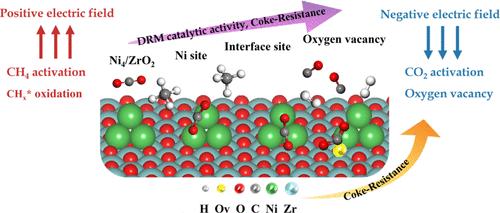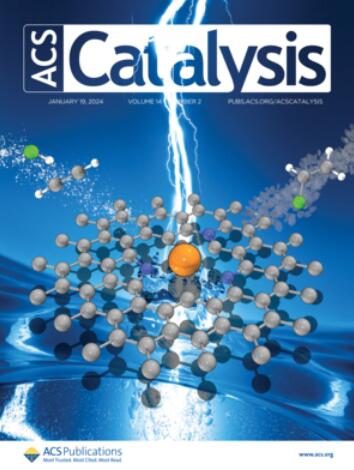A Comprehensive Theoretical Study of the Mechanism for Dry Reforming of Methane on a Ni4/ZrO2(101) Catalyst Under External Electric Fields: The Role of Interface and Oxygen Vacancy
IF 11.3
1区 化学
Q1 CHEMISTRY, PHYSICAL
引用次数: 0
Abstract
Although dry reforming of methane (DRM) reactions is advantageous in environmental and economic aspects, they still face the challenge of catalyst deactivation caused by carbon deposition. Metal-supported catalysts exhibit high activity and stability in DRM reactions due to the ability of strong metal–support interaction (SMSI) to highly disperse Ni nanoparticles and unique interface active sites. Moreover, the external electric field has a significant effect on DRM. Herein, the mechanisms of the DRM reaction on the Ni4/ZrO2(101) catalyst under different electric fields were comprehensively investigated using density functional theory (DFT) and microkinetic modeling to better understand the importance of metal-support interfaces and oxygen vacancies in catalysis. The results indicated that the electric fields weaken the interaction between Ni4 clusters and ZrO2(101). Species are more easily adsorbed and activated at the interface than at only Ni sites. The negative electric fields enhanced CO2 activation, while the positive electric fields promoted methane activation and CHx oxidation, at either the interface or Ni sites. Oxygen vacancies were generated on the Ni4/ZrO2 catalysts by H spillover to form water and were facilitated by negative electric fields. The interface and oxygen vacancies significantly enhance DRM reaction activity and reduce carbon deposition. The surface adsorption dipole moment reflects the tendency of the adsorption strength and reaction enthalpy to change with the electric fields. The microkinetic results showed that carbon deposition is easily formed on the Ni4 cluster, with CH–CH being the predominant type of carbon deposition. Fortunately, the DRM reaction exhibits high reactant conversion under the synergistic effect of Ni clusters and the Zr interface. In addition, oxygen vacancies promote CO2 activation, thereby reducing carbon deposition and enhancing DRM reaction activity, especially with the application of a negative electric field. The positive electric field has the highest DRM reaction activity on Ni4/ZrO2, accompanied by more carbon deposition. Importantly, the negative electric field combines high activity and anticarbon deposition properties. Our results are highly consistent with the experiment. This work emphasizes the importance of interfaces and oxygen vacancies, providing theoretical foundations for a deeper understanding of DRM reaction mechanisms and research in the area of electric- field catalysis.

求助全文
约1分钟内获得全文
求助全文
来源期刊

ACS Catalysis
CHEMISTRY, PHYSICAL-
CiteScore
20.80
自引率
6.20%
发文量
1253
审稿时长
1.5 months
期刊介绍:
ACS Catalysis is an esteemed journal that publishes original research in the fields of heterogeneous catalysis, molecular catalysis, and biocatalysis. It offers broad coverage across diverse areas such as life sciences, organometallics and synthesis, photochemistry and electrochemistry, drug discovery and synthesis, materials science, environmental protection, polymer discovery and synthesis, and energy and fuels.
The scope of the journal is to showcase innovative work in various aspects of catalysis. This includes new reactions and novel synthetic approaches utilizing known catalysts, the discovery or modification of new catalysts, elucidation of catalytic mechanisms through cutting-edge investigations, practical enhancements of existing processes, as well as conceptual advances in the field. Contributions to ACS Catalysis can encompass both experimental and theoretical research focused on catalytic molecules, macromolecules, and materials that exhibit catalytic turnover.
 求助内容:
求助内容: 应助结果提醒方式:
应助结果提醒方式:


